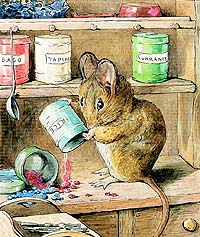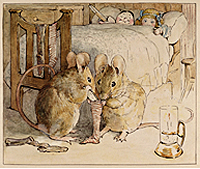 By Ellen Zunon
By Ellen ZunonLittle mouse feet scurry between the cans of scouring powder and silver polish while the Big Ones snore unaware above. It’s a hardscrabble life for a little soul, squeezing oneself in and out through cracks where the wind whistles through and swats your behind and tweaks at your tail and whiskers, and while the wind chimes flail furiously in the winter garden. Once inside the house, it is dark as a whale’s womb, but at least it is warm.
If your night vision is good enough, you can find a feast on the sideboard, perhaps the remains of a piece of marble birthday cake or the crumbs of an almond biscotti on the saucer of the hot chocolate mug left behind by one of the younger Big Ones. But be ready to dash into hiding behind the oatmeal canister if the snoring stops and the Biggest One staggers down the stairs toward the Room of Running Water. Alas, too late, unthinking, you go for a morsel on a wooden plate, and make it to Mouse Heaven.
Besides the Tale of Peter Rabbit, Beatrix Potter wrote many other stories for children about charming little creatures whose human clothing could not hide their mischievous animal natures. One of my favorites, read many times over when my children were young enough to want bedtime stories, was "The Tale of Two Bad Mice," who invaded a dollhouse at night and carried off such loot as a chair, a cradle, a bookcase and a bird cage.
 The culprits were named Tom Thumb and Hunca Munca.
The culprits were named Tom Thumb and Hunca Munca.I always got great amusement from this story with its anthropomorphic protagonists, and I especially liked the pictures of the pair sitting down at the dining room table and trying to carve a plaster ham with tiny tin knives, or trying to drag a bolster pillow down the dollhouse stairs and through their mousehole. I also like their descriptive names: Tom Thumb, a very fitting name for a mouse; but Hunca Munca? A musical rhyming name, perhaps after a pet mouse that Beatrix and her brother kept as children.
And so when a mouse (or mice) moved into the cupboard under my kitchen sink, I could not help thinking of Hunca Munca and her diminutive better half. They reminded me indeed of a pet white mouse my own brother had had when we were children, but who escaped from its cage one time and got loose in the basement,
 much to my mother’s consternation.
much to my mother’s consternation.This new Hunca Munca must have gotten into our house through a chink in the foundation, pushed aside a square of insulation and leaped onto the basement floor. Perhaps she was shown the chink in the foundation by the chipmunk who lives under the front porch.
This Hunca Munca took up residence in the kitchen cupboard, but she ignored the canisters marked Coffee and Rice, which in Potter’s story turned out to have nothing inside but red and blue beads. Instead, she went on foraging forays in the basement storage room, chewing through an imported tapestry and leaving mouse droppings on the pristine white shelves where my daughter’s paintings are stored.
I could not bear the thought that she might try to make a meal out of a masterpiece.
In the story, the owner of the dollhouse declared that she would buy a doll dressed like a policeman. In real life, my sister asked me whether I would like to borrow a cat. She has four. But my husband and I decided somewhat reluctantly to use a conventional mousetrap.
Our first attempt was not successful.
“Did you set the traps?”
I asked my husband as he climbed into bed the first night.
“Uh huh.”
“What did you use for bait?” I asked.
“Huh?”
“What did you use for bait?”
“Nothing. I just set the traps.”
 Not surprising at all, we caught nothing that first night. After all, Hunca Munca and Tom Thumb are not stupid. It was a cat that was killed by curiosity, not a mouse. I knew we had to lure the invaders not with bare wood and wire, but with a tasty morsel.
Not surprising at all, we caught nothing that first night. After all, Hunca Munca and Tom Thumb are not stupid. It was a cat that was killed by curiosity, not a mouse. I knew we had to lure the invaders not with bare wood and wire, but with a tasty morsel.Don’t let anyone tell you that mice like cheese. That didn’t work either. They weren’t interested.
On the third try, not wanting to strike out, I suggested peanut butter (no jelly, please!) on a piece of bread crust. We set two traps.
Bingo! The sight of a dead creature on my basement floor was distasteful, but I consoled myself with the thought that the animal had died a quick death. And I further justified the trap by telling myself that the bacteria that cause Lyme disease lurk in the digestive tracts of mice and squirrels.
So we were better off rid of this rodent after all.
And what of the trap set under the kitchen sink? Yes, there too, behind the wastebasket we found a sprung trap and a diminutive victim. There too, we emptied the trap and swept up the last of the mouse droppings (we hoped).
In Potter’s story, the two Bad Mice were “not so very naughty after all,” because they paid for everything they broke. They found a bent coin (the proverbial crooked sixpence, I presume) under the carpet in the dollhouse, and on Christmas Eve they stuffed it into one of the dolls’ stockings.
 I found no such recompense in any of our stockings on Christmas this year.
I found no such recompense in any of our stockings on Christmas this year.But shortly after the New Year I began to see again tiny black specks of mouse droppings on the clean white basement shelves.
Stick around and maybe I will tell you the Tale of the Third Bad Mouse and how he met his demise.
Writer Ellen Zunon has taught English as a Second Language in the U.S., France and Cote d'Ivoire. She now hangs her hat in Guilderland, New York.
No comments:
Post a Comment